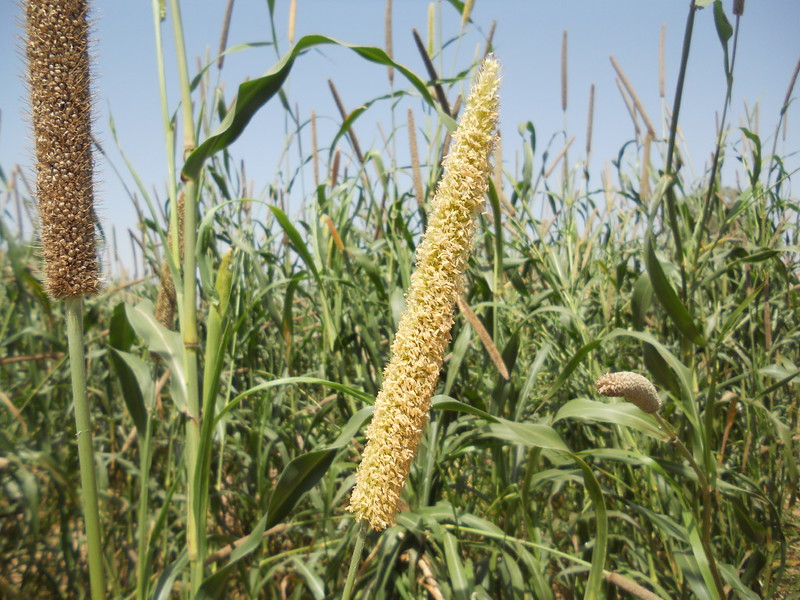Farmers in Zimbabwe are fighting taboo against growing a drought-hardy crop
Sporadic rainfall is drying up large parts of Zimbabwe and devastating maize production. The government recognises that farmers should be cultivating more drought-resistant crops but an unusual cultural fear in rural areas is making changes to farming even more challenging.
S
amuel Mudziwepasi lost his entire maize crop in the last farming season, when a drought ravaged much of Zimbabwe.
Now he fears his next harvest will be just as bad, as his crop is already damaged from a dry spell that hit the country’s eastern regions at the start of this year.
Mudziwepasi knows one way to save his farm in Mambwere village: start growing pearl millet, a drought-resistant grain that could fetch him more money than maize.
But he is not allowed.
Even as persistently poor rains decimate Zimbabwe’s maize harvests, cultivating pearl millet has been effectively banned in many rural areas for generations because traditional leaders consider the crop brings bad luck.
“Growing pearl millet in this area is a taboo,” Mudziwepasi told the Thomson Reuters Foundation.
“We know it is grown in other drought-prone areas, but even in times of drought we cannot grow that crop here.”

Pearl millet is a drought-resistant grain that could be more profitable than maize.
Agricultural experts and government officials agree that planting more drought-resistant small grains, like pearl millet, is essential for the country to adapt to climate change.
Villagers say the reasons for shunning pearl millet differ around the country, but most stem from long-held cultural beliefs.
Blessing Zimunya, a traditional leader in Mambwere village, said growing and eating pearl millet were prohibited there a “long, long time ago”, ever since a predecessor died after eating a meal containing the grain.
“Pearl millet will never be grown again in these areas. Never again,” Zimunya insisted.
He said that even when the community was given pearl millet under food aid programmes, the villagers wouldn’t accept it.
“Just recently we rejected a consignment of pearl millet from the government,” Zimunya noted.
While village elders recognise the need to find alternatives for local farmers struggling to grow thirsty crops like maize, groundnuts and melons, Zimunya said lifting the ban on pearl millet would anger their ancestral spirits.
“If you eat or grow millet in this area, you will suffer,” he said.
Growing the grain is believed to anger ancestral spirits
The consequences of breaking the taboo can lead to families losing their farms and homes.
Claris Madhuku, director of the Platform for Youth and Community Development, a charity working in rural Zimbabwe, said his organisation knew of families who were banished from their villages for growing pearl millet.
In March, a couple was brought before the traditional court in Mashonaland West province on charges of farming the grain.
The group Zimbabwe Lawyers for Human Rights, which is defending the couple, said in a statement the ban on the crop goes against government policy to advocate and promote the growing of small grains. The case is still pending.
Hilal Elver, the U.N. special rapporteur on the right to food, said in a statement last November that more than 60% of Zimbabwe’s population of about 14 million were food-insecure, meaning they do not have enough food to meet their basic needs.
In January, Zimbabwe’s agriculture minister told officials the country had only 100,000 tonnes of grain in its strategic reserves – enough to last just over a month.
As the southern African nation suffers the effects of a severe drought that halved maize harvests last year, the government has started pushing small grains like pearl millet and sorghum as “nutritious and progressive” crops, Madhuku said.
They also consume less water than maize and mature faster, making them less vulnerable to unpredictable dry spells.
“Considering that these small grains are drought-resistant, it makes a lot of sense,” Madhuku said.
“Some of the myths (about pearl millet) that used to be respected and of consequence should no longer be honoured,” he added.
Cash incentives
To encourage more farmers to switch to small grains, in February the government increased the price at which it buys pearl millet, sorghum and finger millet from farmers.
The price paid for small grains went up from 4,000 Zimbabwe dollars ($11) per tonne to 7,260 Zimbabwe dollars, about 300 Zimbabwe dollars more than the maize price, which also increased.
Aware of the pearl millet taboo, the government is also running programmes to educate traditional leaders and others about the grain’s benefits, noted Elisha N. Moyo, principal climate change researcher for the environment ministry.
The push includes workshops, meetings with traditional leaders and agricultural extension officers, and field visits to farms where pearl millet is grown.
Leonard Madanhire, a farmer in Gutaurare near Mambwere, lives in an area where farming pearl millet is allowed.
But he and the other farmers in his village still prefer to cultivate maize because they find it easier to grow and more versatile than pearl millet.
Madanhire said he understands why some farmers whose crops are regularly destroyed by drought would want to cultivate the hardier grain, but warned it will not be easy to convince village leaders in places where the crop is outlawed.
“Culture and traditional beliefs are very strong here and cannot be easily changed,” he said.
Mambwere farmer Ephary Mukwindidza said he could only hope the ban in his village would one day be relaxed to help struggling communities.
“I think the traditional leaders should now allow farmers in these areas to start growing pearl millet to save people from hunger,” he said. “People are suffering here.”
The ideas presented in this article aim to inspire adaptation action – they are the views of the author and do not necessarily reflect those of the Global Center on Adaptation.